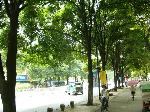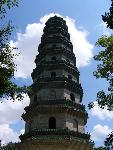- Getting around Lijiang. Dont stay in the Old Towns more than 2 days, there is nothing to do. KRISS Oct 9, 2013 05:46
- 2013 Beijing Temple Fair BENNYLAU Feb 26, 2013 03:29
- Malaysian traveling from KUL - LAX vis Shanghai PVG ZATI_DY Jan 3, 2013 20:15
It’s Easy Being Green
- Views: 5500
- |Vote: 1 1
- |Add to Favorites
- |Recommend to Friends
Chaoyang Road
Stretching away from the city’s central railway station, Nanning’s Chaoyang Road is almost a symbol of the city – colourful, busy, overflowing with local culture and produce from around the province and brought in over the Vietnamese border, and undeniably green. Many cities in China are attractively tree-lined and shady, but in Nanning the presence of the trees feels more endemic – as if the city has no choice but to burst forth in foliage and squeeze palm trees out from between cracks in the pavement.
I’d ventured out early in the morning in search of some breakfast – expecting to feel the tropical heat – but the morning was cool, and wandering down Chaoyang Road in the shade of tall trees was a charming introduction to Nanning. I was looking for somewhere to eat, but most of the shop fronts on both sides of the streets were populated by merchants offering low-priced goods. They called out cheerfully offering bags, trousers and shoes, and smiled good-naturedly as I shook my head and waved back at them. The one comestible item that did appear to be on sale was the region’s cooling drink, called Liang Cha – I was told that the drink originates from Wuzhou far out in Guangxi’s east, but is enjoyed all over the province as the preferred way to counter the heat of the sun.
I’d supposed that the central areas of Nanning would be far more modest in scale than I discovered them to be – for after a ten minute walk I found myself in the central shopping district – vast shopping malls, a McDonald’s and KFC, fashion boutiques and suchlike. I found a small store serving a delicious vegetable rice breakfast with dark-stained tea eggs, and sat a while enjoying the atmosphere.
As a student of Mandarin, one thing that intrigued me was the fact that every street sign had not only the name of each street in Chinese characters subtitled with the standard Romanisation of those words, but also what appeared to be a second version of the same characters in an unfamiliar arrangement of Roman letters – “西关路” was written in standard Pinyin script as “Xi Guan Lu’, but the odd “Sihgvahnlu” above seemed to conform to an entirely different standard. I asked a guard sitting by a local government agency with a particularly large sign carrying this script what the words were, and he told me that they give the pronunciation of the Zhuang minority peoples of the same Chinese words in a script devised for them earlier last century by a Russian advisor.
Through the City
I was intending to go to Nanning’s largest scenic reserve, Qingxiushan, an area that is situated about 5 km from Nanning and lies next to the Yijiang River. The area, I’d been most curious to read, is often called the lungs of Nanning – an odd comparison that I took to refer to the fresh air and purifying action of the river and trees. Qingxiushan is delicately forested over an area of 800 hectares, providing a good concentration of Nanning’s claim to being ‘green’. The mountain itself is no towering peak, standing at only 200Km above sea level, but I also read that within the reserve, the sound of the wind rushing about the trees creates a distinctive shush known as the Pine Wave – the swaying of the trees resembling something like the ocean tide.
Bus routes on the local map were difficult to make out, but I chanced upon a stop on the number 10 line on Chaoyang Road, which I had read goes directly to the park. The bus was cool and uncrowded, and I enjoyed the chance to travel through the suburbs. Nanning is an attractive city on a human scale, and although it is devoid of the wonderful ancient Chinese artefacts and architectural leftovers that make so many locations in China fascinating places to travel through, Nanning exhibits itself in an infectiously positive manner that probably leaves many a visitor with the suspicion that it would make a rather fine place to live. I for one could not shake the feeling that a move to Nanning might be an appealing choice and spent the trip to Qingxiushan dreaming that the bright, clean streets I was passing by were home.
Qingxiushan
In the full bright sunshine, the grand entrance to the Qingxiushan Reserve has a casual magnificence that I have come to associate with the laid-back, clean culture of tropical China and Chinese-influenced Southeast Asia. I stepped up to the gate in an entirely positive mood and paid the RMB15 entrance fee, stepping through into a wide park area laid in fresh grass and colourful flowers. Mototaxis were signalling at me wildly – I found this to be quite odd, as it was obvious I’d already arrived at the park and quite clearly wouldn’t require a ride – that was, of course, until I carefully examined the small map on the back of my ticket and realised that I was almost an hour’s walk away from the main attractions of the park. Both the western and northern gates to Qingxiushan are far from the action, and I briefly considered going back to the taxis before decided to make the walk anyway, hot as it was, to see the few sights along the way.
The road from the main gate is actually quite lovely and well worth the effort required to walk the distance. I passed through the light forests and orchards that reminded me of my home in New Zealand, watching out over the increasingly splendid view of the city from a distance. A number of orchardists stood by their fruit stalls – much of their produce I found difficult to recognise, although the fruit looked succulent and delicious – and noted that many of the orchards invited visitors to enter and pick their own selection straight from the tree.
I also passed a few attractive tourist areas – the ASEAN friendship garden, a wide lawn with a long bamboo corridor offering good views over the river, and a monument to student martyrs of the anti-Japanese war. Under the summer light, the park was shamelessly seductive – a day spent with a lover strolling through the grass and trees would be anyone’s honeymoon for a day.
The Heavenly Pool
In the centre of the tourist attractions, the Heavenly Pool is rather ostentiously named – there are a couple of remote mountain lakes in China which share the name, but this one, although a lovely little lake nicely reflecting the ornate Dragon & Elephant Pagoda behind it, doesn’t quite compare with its namesakes. After an hour’s walk, however, I was glad to rest at the lake’s edge and watch the huge brightly coloured fish gather about the snacks thrown out at them by happy tourists, of which there were only but few.
I wandered about the location in the best of moods. Firstly I stopped in to visit the Water Moon Nunnery, one of the most colourful temples I’ve seen in China. With pillars and sidings in tangerine and apricot and lemon yellow walls, the temple looked like it was made out of candy. Nuns live here in adjoining dormitories that connect seamlessly with the temple – and I couldn’t help but smile to see their living quarters intimately blended with the halls of worship – a great, garishly decorated idol sat in front of its incense pot next to a dirty fridge and microwave oven that seemed typical of any student dormitory worldwide.
The Pagoda is the tallest tower in all of Guangxi, standing at 60m high, and from the top visitors are treated to a stunning view of the countryside and city. It’s a hard climb, however – as I entered, I saw the first European face I’d seen since leaving Beijing – a Finn who was embarking on what he described as a ‘rather dull tour of the country’ – he looked at me sufferingly and and pointed to the stairs, saying simply, ‘it’s hell’.
It wasn’t so bad though, and I loved the view – not only could I see a wide vista of the southern Guanxi heartland, but I could also see several of the stunning traditional buildings in the park – particularly the Jilin Ge, an exclusive restaurant in an ornate style only open for pre-booked tour groups, and the Thailand Garden, which contains some attractive Thai architecture. The tower I was standing in had to be the most alluring feature of the park though – it was only a reconstruction in Ming style, however, the original ancient tower being an odd casualty of wartime history, being bombed not by the enemy but by the Chinese themselves who feared that Japanese bombers might use the structure as a marker for targeting the city.
I spared myself the walk back to the gates – a tourist bus circles the park at RMB5 a ticket – and found the stop for a connecting bus all the way back to the railway station and my little hotel at the edge of the station grounds. It was already late in the afternoon, and Nanning was looking splendid, and I found myself with the altogether pleasant sensation of having found yet another cheerful and lovely spot on Earth.







 Copyright © 1998-2025 All rights reserved.
Copyright © 1998-2025 All rights reserved.
1.
Jan 24, 2011 07:07 Reply
ROYGWYNN said:
A welter of info about Nanning on the internet, but Mr Mishens travelogue gives a human feel, and detail you cannot feel in the internet. I am writing to someone in Nanning, and Mr Mishen took me on a journey that I was able to feel, and imagine. He writes with wonderful humanity, and is so much more than a casual observer. Torrents of detail are easy, but a feel of the place is not easy to transmit,. I could almost feel the humidity in our walk through the park, and, at the end of the day, I was glad to arrive back at his little hotel by the railway.
Many thanks****